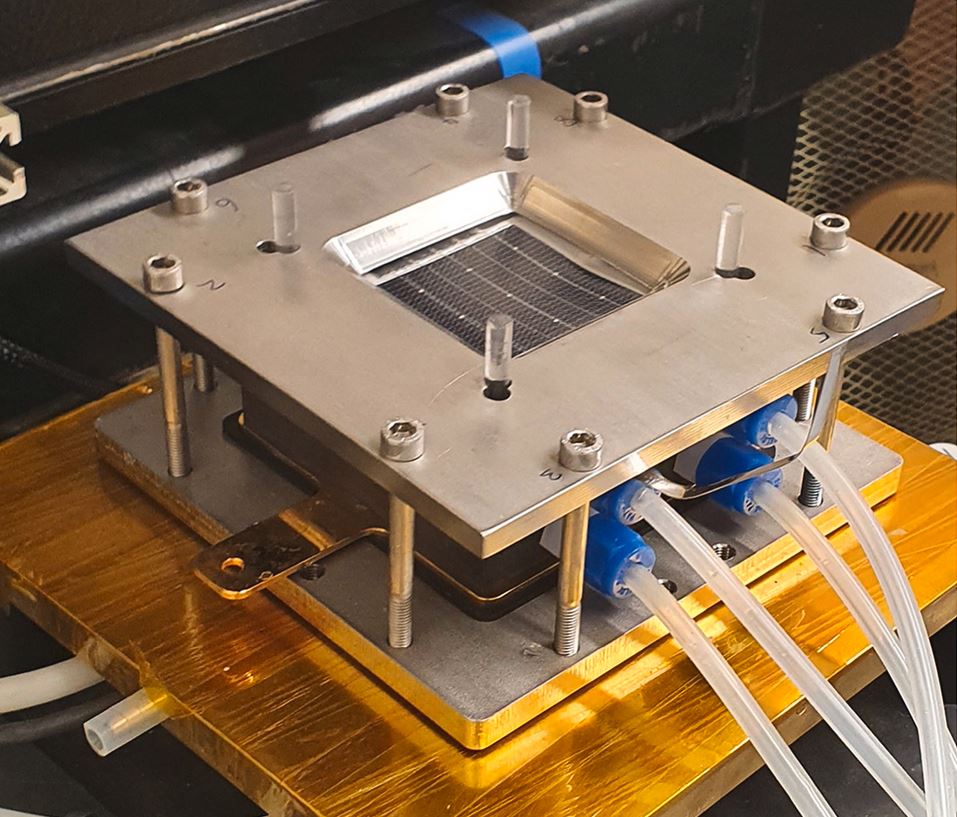
The PV-driven redox flow battery can reportedly achieve a maximum solar-to-output electricity efficiency of 3.11% during a 36-hour period. The system incorporates a 25 cm2 heterojunction photovoltaic device and is based on a neutral pH aqueous iodine-bromine redox couple.
Solar redox flow cells (SRFCs) are devices that can store electricity by harvesting sunlight via a photoelectrochemical (PE) panel. These storage devices are attracting increasing interest from scientists and research institutes and have been developed so far only at research level.
Two of the biggest challenges these batteries have to overcome, along with other minor issues, are the fact that their performance is restricted by inefficient photoelectrochemical reactions and that their storage capacity is limited by the physical dimension of solid electrodes.
With this in mind, a group of researchers in the United Kingdom has developed a solar redox flow battery that uses a PV unit instead of a PE system and is based on a neutral pH aqueous iodine-bromine redox couple.
The system is the largest storage system of this kind ever built to date, according to its creators.
The battery incorporates a 25 cm2 heterojunction (HJT) photovoltaic device based on an M2 Czochralski (CZ) wafers with a resistivity of 1–5 Ωcm and a thickness of 130 μm and is placed on a stainless-steel outer frame measuring 160 mm × 160 mm x 8 mm with a 50 mm × 50 mm window for hosting the PV device. The cell layers are secured through guide bars added to each corner of the window.
“Two rubber spacers with size 110 mm × 110 mm x 2.5 mm and a window size of 65 mm × 65 mm were applied,” the scientists explained. “The window cutouts in the rubber surface are larger than the PV charging device’s active area, preventing shading and the application of direct pressure. A rubber gasket was chosen to avoid unintentional conduction of electricity between cell layers.”
In the proposed system configuration, the electrode of the PV device is connected to the bipolar plate of the RFB cell, with the cathode being connected to a potentiostat.

Image: Heriot-Watt University, Journal of Power Sources, CC BY 4.0
The research team conducted an experimental evaluation on the selected redox couple to assess its compatibility with the PV device’s operating voltage, which is responsible for charging the SRFB system. It also analyzed a competitive osmotically balanced neutral pH aqueous iodine/bromine redox couples combination, which they said is the innovative side of the SRFB.
The analysis considered, in particular, the couple’s redox potential, operating voltage range, and solubility and found it “effectively matched” the operating profile of the PV unit.
“The aligned I-V curves of the PV cell and SRFB regime minimized the concentration overpotential of electrolytes and ensured stable operation within the desired potential range,” the academics explained. “Moreover, our investigation into the electrochemical properties of the iodine-bromine redox couple revealed its favorable reversibility and stability, as evidenced by cyclic voltammetry and charge/discharge experiments.”
The experiment also showed that the “osmotically controlled electrolyte” improves the battery’s cycle reversibility and discharge capacity retention rate by mitigating concentration gradients between the anolyte and catholyte.
The system was also found to achieve a 9.54% solar-to-chemical efficiency and a maximum solar-to-output electricity efficiency (SOEE) of 3.11% during a 36-hour period, which is claimed to be the longest operation among the single-cell-based SRFB systems ever achieved to date.
The device is described in detail in the paper “A 25 cm2 single Si-based solar redox flow battery with aqueous iodine-bromine redox couples,” published in the Journal of Power Sources. The research team included scientists from Loughborough University and Heriot-Watt University in the United Kingdom.
“Considering the dimensions of commercially available crystalline silicon photovoltaic devices, we anticipate that future large-scale SRFB systems will probably consist of interconnected multiple individual modules, each with an active area in the range of 200-400 cm2,” they said, referring to the future direction of their work.
This content is protected by copyright and may not be reused. If you want to cooperate with us and would like to reuse some of our content, please contact: editors@pv-magazine.com.
Source link


